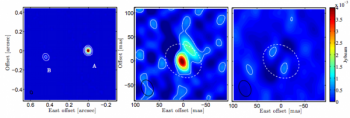 We present the size, shape and flux densities at millimeter continuum wavelengths, based on ALMA science verification observations in Band 3 (~94.6 GHz) and Band 6 (~228.7 GHz), from the binary Mira A (o Ceti) and Mira B. The Mira AB system has been observed with ALMA at a spatial resolution of down to ~25 mas. The extended atmosphere of Mira A and the wind around Mira B sources are resolved and we derive the size of Mira A and of the ionized region around Mira B. The spectral indices within Band 3 (between 89-100 GHz) and between Band 3 and Band 6 are also derived. The spectral index of Mira A is found to change from 1.71+-0.05 within Band 3 to 1.54+-0.04 between Band 3 and 6. The spectral index of Mira B is 1.3+-0.2 in Band 3, in good agreement with measurements at longer wavelengths. However it rises to 1.72+-0.11 between the bands. For the first time the extended atmosphere of a star is resolved at these frequencies and for Mira A the diameter is ~3.8x3.2 AU in Band 3 (with brightness temperature Tb~5300 K) and ~4.0x3.6 AU in Band 6 (Tb~2500 K). Additionally, a bright hotspot of ~0.4 AU and with Tb~10000 K is found on the stellar disc of Mira A. The size of the ionized region around the accretion disk of Mira B is found to be ~2.4 AU. The emission around Mira B is consistent with that from a partially ionized wind of gravitationally bound material from Mira A close to the accretion disk of Mira B. The Mira A atmosphere does not fully match predictions, with brightness temperatures in Band 3 significantly higher than expected, potentially due to shock heating. The hotspot is likely due to magnetic activity and could be related to the previously observed X-ray flare of Mira A.
We present the size, shape and flux densities at millimeter continuum wavelengths, based on ALMA science verification observations in Band 3 (~94.6 GHz) and Band 6 (~228.7 GHz), from the binary Mira A (o Ceti) and Mira B. The Mira AB system has been observed with ALMA at a spatial resolution of down to ~25 mas. The extended atmosphere of Mira A and the wind around Mira B sources are resolved and we derive the size of Mira A and of the ionized region around Mira B. The spectral indices within Band 3 (between 89-100 GHz) and between Band 3 and Band 6 are also derived. The spectral index of Mira A is found to change from 1.71+-0.05 within Band 3 to 1.54+-0.04 between Band 3 and 6. The spectral index of Mira B is 1.3+-0.2 in Band 3, in good agreement with measurements at longer wavelengths. However it rises to 1.72+-0.11 between the bands. For the first time the extended atmosphere of a star is resolved at these frequencies and for Mira A the diameter is ~3.8x3.2 AU in Band 3 (with brightness temperature Tb~5300 K) and ~4.0x3.6 AU in Band 6 (Tb~2500 K). Additionally, a bright hotspot of ~0.4 AU and with Tb~10000 K is found on the stellar disc of Mira A. The size of the ionized region around the accretion disk of Mira B is found to be ~2.4 AU. The emission around Mira B is consistent with that from a partially ionized wind of gravitationally bound material from Mira A close to the accretion disk of Mira B. The Mira A atmosphere does not fully match predictions, with brightness temperatures in Band 3 significantly higher than expected, potentially due to shock heating. The hotspot is likely due to magnetic activity and could be related to the previously observed X-ray flare of Mira A.
Authors: W.H.T. Vlemmings, S. Ramstedt, E. O'Gorman, E.M.L. Humphreys, M. Wittkowski, A. Baudry, M. Karovska

